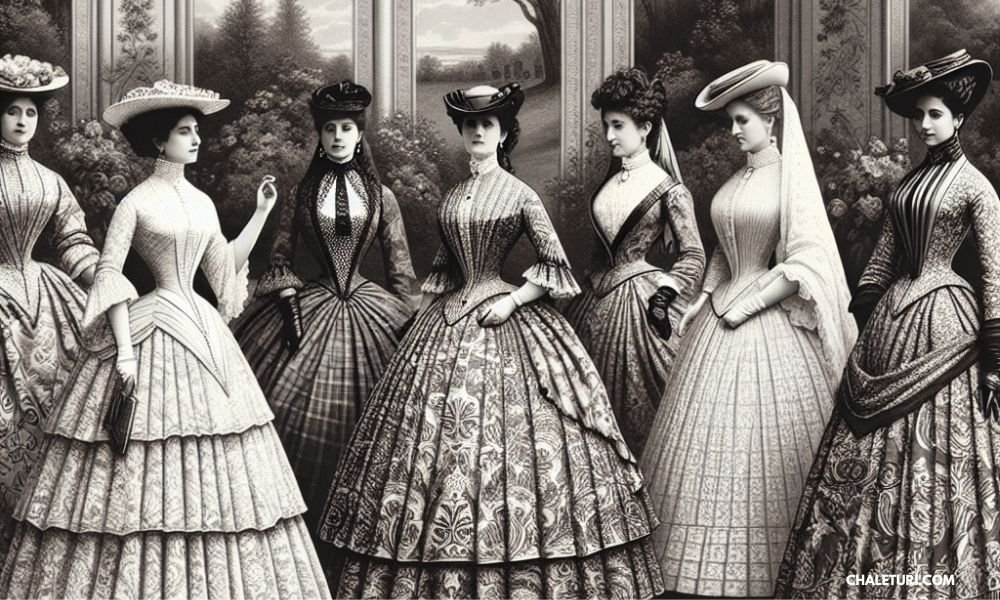Only a few textiles can be said to have influenced the history of fashion; hence, 1800s women’s damask fashion is one of those few. Due to its bright hues, this patterned decorative fabric became one of the more stylish and expensive fabrics used in 1800s womans damask fashion. Due to its beauty and the artistry in making it, it has, through the ages, retained a working-class image, is well-to-do, and is luxurious. This time, we researched the theme, features, and use of 1800s women’s damask fashion, which was popular in the 19th century.
The Allure of Damask in the 1800s
Damask is viewed as a fashion icon, mainly through the 1800s. This geo-strategic product, which traces its origins to China and the Middle East and is made of woven fabric, was swiftly marketed throughout Europe as a cultural and wealth indicator. It comes from Damascus in Syria, connected with the so-called Silk Road. By the time the fabric came into the 1800s, European dresses had already been associated with wealth and sophistication.
The fashion of damask was often equated with aristocracy and high society in this epoch. Every rich and noble man wore something made from this beautiful fabric, and they wore these things not only because they were rich but also because they loved art. Damask was not just restricted to its use on clothing; it spilled over into furnishing, providing beautiful and elegant prints. It became the perfect imagery of class, which every social stratum wanted to evoke!
Weaving Wonders: The Unique Attributes of Damask Fabric
Twill is an intricate cloth that is enjoyable because of the styles in which it is woven, creating overlapping motifs. That is an involved technique, requiring one to use one or more source colors to design against another or to use the effects of contrast and light even if it is the same color. It is indeed fabric that would wow any viewer irrespective of the view angle, giving garments added depth and dimensions.
It was created using natural fibers such as silk asm, linen, and wool smear to make the damask beautiful and robust. Its solid structure made it a suitable material for making soft clothes that last long. It is fashionable as it balances the aesthetic and is ideal for wearing a damask because it combines the designed aspect with the garment usage.
Most of the time, damask fabric contained florals, shapes, figurines, and some navy coat patterns. Such designs were not just decorations; they were usually imbued with their relation to the family, the individual, or the fashionable tendencies of the time. The trends of damask were such that in every other aspect, women could never run short of damask fabric owing to their richness in variety.
Fashion Through the 1800s Trends Featuring Damask
During the nineteenth century, there were notable changes in fashions, including the damask used in women’s clothing. It was during the earlier part of the century that the empire silhouette was fashionable. Featuring a low-bodice and high-waisted silhouette, this trend preferred long gowns with sheath-like drapelike figures. So, despite the more significant opportunities afforded by the engagement of damask fabrics in many evening dresses and formal dress-making women’s clothes.
In the mid-1800s, Crinolines and bustles made their fashion more rigid, including figure-enhancing skirts or supports that stiffened the gown’s hem. These wearable objects were also made from fabric materials that could hold onto their forms without betraying their beauty. The sturdiness and texture of damasks made them perfect for these structured styles. There was also pressure from the world of sociopolitics of the time regarding the fashions adopted by boiling women and their anxieties and politics of projecting power, stability, or control.
In the second half of the century, fashion continued to change, with the collection of Damask remaining mostly fashionable through newer collection trends and fashion ideas emerging. Advances in color dye and the processes of weaving made it possible to introduce more colors and complicated patterns. Damask fabric was taken on by eminent designers of that time under the pretext of style culture to create garments that break the fashion stereotype.
Dressing in Damask Types of Garments and Accessories
The damask fabric penetrated various kinds of costumes, each one having its own beauty and use. Damask outfits were mostly dresses and gowns, with evening ones also being exquisitely embroidered and elaborately decorated. Evening wear calls for more elaborations and rich fabrics. Dresses made of damask for day-to-day use were functional with a subtle class, making them perfect for social outings or casual walks.
The usefulness of damask is equally applied to wraps and other garment fittings. This class of fabric was augmented with jackets and shawls for fashion and warmth during cold weather. Some embellishments and trimmings were worn to uplift the dress code so that they responded very well to the mood of the occasion.
Preserving the Past Care and Maintenance of Damask
Damask, as well as damask linen, pointedly requires usage and management in order to uphold the aesthetics of this quite beautiful fabric. The processes for cleaning also include dry cleaning, which is preferable since it is gentle on the damask material and the most convenient. Stain treatment and targeted cleaning are practical and helpful in reducing damage and improving the performance of wearables.
While preserving damask fabric care should be taken to protect the weight from heat and vapor since it can cause heat-related effects. The prevention of damage and draping distortion of fabrics indoors is made possible with the correct application of padded hangers and garment bags.
The Modern Renaissance of Damask Fashion
Hundreds of years have elapsed, yet damask fashion remains a source of creative inspiration to designers and fashion lovers alike. Present-day collections always include some damask fabric, which speaks tones of older styles mixed with the existing ones. Designers take this art back to the factors where damask was used to make fashionable pieces for today’s market.
Vintage damask pieces are expensive, and most are collected by people who appreciate their history. The remnants of historical dares help us step backward even as we enjoy the immortality of damask fashion.
Conclusion The Timeless Elegance of Damask
The passion for damask fashion speaks to how strong and attractive it is. Owing to the elaborate designs, deep historical background, and cultural significance, the damask still remains a mark of class, devoid of time limits. From its presence in ancient trade routes to its prominence in women’s fashion in the late 1800s, the product continues to captivate.
Suppose readers want to know more about the marvelous chronicles of textiles and fashion. Why not use the chance to get acquainted with the collections and exhibitions of such magnificent fabrics? If you are looking for the history of fabrics or like to wear a suitable fabric, nightingale, then the story of this fabric is for you.
Frequently Asked Questions (FAQs)
What makes damask fabric unique?
Due to its complicated weave structure and the variances in color or light that contribute to the picture and feeling, damask excels in having sumptuous, intricately designed patterns that are reversible. This distinguishes it from the rest of the cloth in that the fabric is visually appealing and touchable.
How do I care for my damask garments?
Taking care of the damask is a bit more complicated than that. It is advisable to dry clean the damask to maintain its soft and delicate features. To retain the condition of the garment, it is best to avoid sunlight and humidity and to use padded hangers and garment bags for storage.
What types of clothing are commonly made from damask?
Damask is a fabric commonly used in many outfits, including formal gowns, day dresses, jackets, shawls for outerwear, and some accessories. It can be worn and designed for comfortable day wear or beautiful evening dresses.
Can I find modern garments made from damask?
Yes, however, damask is still part of the many collections created by modern fabrics. These pieces are characterized by vintage touches, with modern trends propelling the fashions and pushing the present-day fashion followers.
What are some common patterns found in damask fabrics?
Traditionally, the structure of a damask incorporates floral designs, geometric patterns, and emblems. These designs usually encapsulate elements of history, family values, individual values, or other features of society that reinforce their aesthetic qualities.
Is damask fabric durable?
The same goes for the definition of damask fabric; it is very durable. This fabric was known to be made from solid and sturdy natural fibers like silk, linen, and wool, and thus, it could face the hands of time while looking beautiful. This quality is why it is best suited for garments that incorporate both aesthetic and functional qualities.
Where can I learn more about Damask and its history?
Another way to learn more about the specifics of damask and textile history is to visit collections and exhibitions of historical fabrics in the museums. Southeastern Louisiana University offers an abundance of learning resources regarding the glorious past and beautiful present of damask ladies’ fashion.




